When Khalid and Abdul, our driver and guide respectively from Love Egypt Tours, dropped us off last night after visiting the tombs at Dendera and Abydos, they had asked us if we could take the ferry across the Nile this morning from our hotel on the West Bank as today's sights were on the East Bank of the Nile. That was no problem as our hotel was only a three minute walk from the ferry.
Our very early trip across the Nile:
Early morning commuters off to work on the East Bank:
Early morning shot from the ferry of Luxor Temple that we had visited our first day in Luxor:
Kathy: I am pretty sure these were ReMax balloons.
Looking back to the West Bank:
Holding on for dear life:
It was easy to understand why the road was named the Agricultural Road when we kept passing so many verdant fields and banana plantations.
After an hour or so, it was great driving next to the Nile for a good stretch.
Abdul said we were coming up on El Kab, the oldest city in Egypt at 7,000 years old.
The city was surrounded by walls and had caves in the hills, according to Abdul.
Our first stop was the Temple of Edfu located 110 kms and a two hour drive south of Luxor. It was dedicated to Horus who was known as the falcon god. Construction on the temple began in 237 BC under the direction of the Greco-Romans and Ptolemy III. We thought Abdul was joking when he said that the ribbon cutting took place 180 years later in 57 BC during the reign of Cleopatra VII, i.e. the most famous Cleopatra.
Abdul stated that of all the temple remains in Egypt, the Temple of Edfu is the most completely preserved. To reach the Temple, we had to pass a lot of horse and buggies carrying passengers from the cruise ships who had docked on the nearby Nile.
The entrance to the Temple was certainly impressive as the facade was 20 meters high.
As we got closer to the Temple's original wall, we could see huge battle scenes depicted, just like we had seen at the Habu Temple.
One of the columns actually did portray the ribbon-cutting ceremony that Abdul had told us about!
The 42 differnt provinces of Egypt were listed on this wall.
Each province was represented by a differnt flower:
One fascinating carving was the depiction of the battle between Horus and his arch enemy, Seth, showing Seth in the form of a hippo, a symbol of evil.
One of the largest Tree of Life scenes we'd seen:
I was standing where the ancient Egyptian royal families had stood to watch festivals in the open courtyard.
The size of the courtyard was just immense as befitting a royal family. We enjoyed our visit to the Temple as it was one of the best places to really imagine the grandeur of ancient Egypt. Although the colors from the wall scenes were gone, the building was very well preserved given its antiquity.
Back on the Agricultural Road, driving further south, here was one of the 'signs' indicating a speedbump! Other times we saw a garbage can as the marker.
We saw many of these same beautifully flowering bushes along the highway as we drove toward the Temple of Kom Ombo next. I believe Abdul said these were hibiscus flowers and which are often used to treat high blood pressure. Lotus flower oil is used for the hands and cumin for stomach ailments, Abdul added.
The city of Kom Ombo, a garrison town under every dynasty of Egypt as well as Pharaonic, Macedonian and Roman control located 50 kms north of Aswan, was celebrated for the magnificence of its temples.
Kom Ombo, constructed during the 2nd century BC, is the only double temple in Egypt as it was dedicated to Sobek, the crocodile god, and Horus, the falcon-headed god. There were two temples in one with each side having its own gateways and chapels.
Abdul explained that people dismantled the blocks to build the city.
The columns on both sides of the imposing entranceway were destroyed as was the sanctuary. There was just a little color that was still visible. Mi, the god of justice, held a sword to divide the temple into two. Kom Ombo was known as the Mountain of Gold as 'Kom' meant mountain and 'Ombo' was the word for gold.
A Roman cartouche for Cleopatra II's husband, Ptolemy VI:
A woman giving birth:
Medical scales with strawberries and other fruit shown on the top:
We quickly toured the Crocodile Museum at the temple.
The mummified crocodile, placed on a bier and balanced on a plinth like a wooden shrine, was probably a sacred crocodile revered during its lifetime and preserved for eternity! According to the tag, sacred crocodiles were often bejeweled and even had their nails gilded. What lucky crocs!
I got a kick out of this mummified croc!
We left Kom Ombo at 11:30 for our next destination, the Unfinished Obelisk by Aswan. On the way we noticed how lush the area was south of Kom Ombo and couldn't help but admire the marvelous views of the Nile too.
The granite in the Giza pyramids near Cairo came from here in Aswan, 540 miles away. What a huge distance when you consider the pyramids were built so many thousands of years ago. The granite was floated down the Nile to Giza when the river flooded.
Before visiting the obelisk, it was great to relax for a few minutes at a restaurant on the outskirts of Aswan.
We had never seen so many different types of pasta in one dish before. I found it too highly spiced but Steven ate a good chunk of it.
Aswan is very famous for the granite quarries, and the most visited one is the so-called The Unfinished Obelisk Quarry on the east bank of Aswan.
Possibly intended by Queen Hatsheput as a companion to the Lateran Obelisk, originally at Karnak and now in Rome, it would have measured 120 feet and weighed over 1,150 tons when complete. If the project had been completed, it would be the tallest obelisk in the world. The tallest one now at 33 meters tall, is in Italy and was made by Pharaoh Tuthmosis III.
Quarrymen apparently abandoned the obelisk when fractures appeared in its sides. It still lies where a crack was discovered as it was being hewn from the rock.
The bottom side of the obelisk was still attached to the bedrock. The unfinished obelisk offered unusual insights into ancient Egyptian stone-working techniques. There were marks from workers' tools still clearly visible as well as ochre-colored lines marking where they were working.
This perspective gives a good sense of how gigantic the obelisk was.
It was awfully hot clambering over the rocks so we were so glad we hadn't come in the blistering heat of summer. Seeing the unfinished one still in the ground was worth the visit. To think that the obelisk and other impressive monuments were all quarried with hand tools in the hot Egyptian sun was astounding.
Construction of the High Dam became a key objective of the Egyptian Government following the Egyptian Revolution of 1952, as the ability to control floods, provide water for irrigation and generate hydroelectricity were seen as pivotal to Egypt's industrialization.
Before the dams were built, the Nile flooded every year during late summer, when water flowed down the valley from its East African drainage basin. These floods brought high water and natural nutrients and minerals that annually enriched the fertile soil along the floodplain and delta; this had made the Nile valley ideal for farming since ancient times.
Because floods vary, in high-water years the whole crop might be wiped out, while in low-water years, widespread drought and famine occasionally occurred. With the reservoir storage provided by the Aswan dams, the floods could be lessened and the water stored for later release. Power from the dam extends all the way to Cairo, Abdul said.
This was just a smidge of man-made Lake Nasser where the water flows south up to the Mediterranean. Part of the 500 mile-long lake is in Sudan. Abdul pointed out how the black line indicated the water level was three meters lower compared to normal in the lake.
The total number of stones used in the construction of the dam was 17 times the number of blocks used to build the Great Pyramid in Giza!
Steven and I are so glad we insisted on seeing the Aswan High Dam on this really long day trip from Luxor. Because of its magnitude, the dam has to be considered one of the world's top engineering feats. If you ever want to realize how small you really are, this was the place to be!
Abdul and we were the only passengers in a boat heading over to Philae Temple. Philae, which means ‘the end’ in Greek, defined the southernmost limit of Egypt. The temple, begun by Ptolemy II and completed by the Roman emperors, was dedicated to the goddess Isis, the wife of Osiris and mother of Horus.
Isis was a very important figure in the ancient world. She was known as ‘Mother of God’ and was represented with a throne on her head. During the Roman period, her cult spread throughout Greece and the Roman empire. There was even a temple dedicated to her in London.
Abdul again pointed out the low water level.
I loved seeing the rocks' reflection in the late afternoon sun.
The temple at Philae was nearly lost under water when the High Aswan Dam was built in the 1960s. Fortunately the temple was rescued by a joint operation between the Egyptian government and UNESCO.
In an engineering feat to rival the ancients, the whole island was surrounded with a dam and the inside pumped dry. Then every stone block of the temple complex was labeled and removed, later to be assembled, like a giant jigsaw puzzle, on the higher ground of Agilka Island. The whole project took ten years but it saved one of Egypt’s most beautiful temples from certain destruction.
Abdul told us that Cleopatra's Needle, which had stood here, was stolen by an Italian in 1816 and is now in London.
Can you even imagine dismantling this humongous building and then putting it back together again? I don't know what word or phrase to use that I have not already used so many times to describe the wonder I had when viewing the temple. At least there were no feet put back upside down unlike one of the temples in Luxor!
So much of the facade was sadly destroyed.
We could read that Napoleon had visited Philae Temple and left his mark on the wall.
There was Latin 'graffiti' on the wall between the two figures. You can see it clearly in the second picture.
Our very early trip across the Nile:
Early morning commuters off to work on the East Bank:
Early morning shot from the ferry of Luxor Temple that we had visited our first day in Luxor:
Kathy: I am pretty sure these were ReMax balloons.
A public water fountain in Luxor:
We had our longest day planned yet in Egypt as we were going all the way from Luxor south to Aswan Dam and had several sights to see en route. This time we took the Agricultural Road which was a fascinating experience.Holding on for dear life:
It was easy to understand why the road was named the Agricultural Road when we kept passing so many verdant fields and banana plantations.
After an hour or so, it was great driving next to the Nile for a good stretch.
I felt sorry for Khalid, our marvelous driver, though, as he could never drive at a steady rate of speed because there was virtually one speed bump after another. The were used to control speed as we approached schools, a village or town or sometimes for no apparent reason at all. Some of the speed bumps were marked with a pile of rocks in the center of the road or some other hazard, sometimes not at all!
One local butcher's:Abdul said we were coming up on El Kab, the oldest city in Egypt at 7,000 years old.
The city was surrounded by walls and had caves in the hills, according to Abdul.
Abdul stated that of all the temple remains in Egypt, the Temple of Edfu is the most completely preserved. To reach the Temple, we had to pass a lot of horse and buggies carrying passengers from the cruise ships who had docked on the nearby Nile.
The entrance to the Temple was certainly impressive as the facade was 20 meters high.
As we got closer to the Temple's original wall, we could see huge battle scenes depicted, just like we had seen at the Habu Temple.
Rather than seeing more battle scenes, it was refreshing seeing these dancing figures!
In the open courtyard, there were 16 columns on each side. The entrance was flanked by two huge, exquisite granite Horus falcons.
Horus was portrayed with angry eyes as no one was allowed to enter there. I though the statue looked a little like the 'angry birds.' The statue was in incredible shape as, like so many other temples we'd seen, it was covereed by sand for so long.
We could see once again the smoke marks on the roof where the Christians burnt fires within the complex.
One of the columns actually did portray the ribbon-cutting ceremony that Abdul had told us about!
The 42 differnt provinces of Egypt were listed on this wall.
Each province was represented by a differnt flower:
For the first time, offerings of perfume were made instead of food. Some of the scenes showed Egypt's first laboratory as the liquids from different flowers were used as medications. Abdul mentioned that sandalwood is still used by Egyptians to cure aches and pains. It is a far cheaper alternative to conventional medications, he said.
One fascinating carving was the depiction of the battle between Horus and his arch enemy, Seth, showing Seth in the form of a hippo, a symbol of evil.
One of the largest Tree of Life scenes we'd seen:
Abdul showed us where the Christians had chiseled a cross on the red granite wall.
One of the best preserved boats at any temple, Abdul said.
By the sanctuary, there were eleven rooms used for storage. In one, we saw again Nut, the sky goddess, portrayed on the ceiling.
Bats were only present in this one room!
We encountered more tourists at Edfu than at amy of the other temples during our four days in and around Luxor.
I was standing where the ancient Egyptian royal families had stood to watch festivals in the open courtyard.
Back on the Agricultural Road, driving further south, here was one of the 'signs' indicating a speedbump! Other times we saw a garbage can as the marker.
We saw many of these same beautifully flowering bushes along the highway as we drove toward the Temple of Kom Ombo next. I believe Abdul said these were hibiscus flowers and which are often used to treat high blood pressure. Lotus flower oil is used for the hands and cumin for stomach ailments, Abdul added.
The city of Kom Ombo, a garrison town under every dynasty of Egypt as well as Pharaonic, Macedonian and Roman control located 50 kms north of Aswan, was celebrated for the magnificence of its temples.
Kom Ombo, constructed during the 2nd century BC, is the only double temple in Egypt as it was dedicated to Sobek, the crocodile god, and Horus, the falcon-headed god. There were two temples in one with each side having its own gateways and chapels.
Abdul explained that people dismantled the blocks to build the city.
The columns on both sides of the imposing entranceway were destroyed as was the sanctuary. There was just a little color that was still visible. Mi, the god of justice, held a sword to divide the temple into two. Kom Ombo was known as the Mountain of Gold as 'Kom' meant mountain and 'Ombo' was the word for gold.
Sobek is associated with the wicked god, Seth, the enemy of Horus. In the Horus myth the allies of Seth made their escape by changing themselves into crocodiles. Sobek’s chief sanctuary was at Kom Ombo, as there were once huge numbers of crocodiles in the adjacent Nile.
Sobek, the crocodile god:A Roman cartouche for Cleopatra II's husband, Ptolemy VI:
Only one of the original eight columns remained.
Surgical instruments such as needles, scalpels, scissors, forceps, suction cups and stethoscopes - all in use today - were depicted!
This was the birth chair, Abdul said. Sure didn't look terribly comfortable!
The offering buildings right by the Nile were destroyed.
This measured the height of the Nile to know when it would likely flood. It reminded us of having seen the Nileometer in Cairo that also had the same purpose.
Because we were so much further south than Luxor, it was considerably hotter here in Kom Ombo than it has been the last few days.
We quickly toured the Crocodile Museum at the temple.
The fuzzy photo of the bronze figure of Sobek was once enhanced with inlaid or enamelled colors. It depicts the well muscled human body with a crocodile head wearing a headdress of ram horns and surrounded by a sun disk and feathers.
Photos from the outskirts of Aswan:
Before visiting the obelisk, it was great to relax for a few minutes at a restaurant on the outskirts of Aswan.
We had never seen so many different types of pasta in one dish before. I found it too highly spiced but Steven ate a good chunk of it.
Aswan is very famous for the granite quarries, and the most visited one is the so-called The Unfinished Obelisk Quarry on the east bank of Aswan.
Abdul left us while we hiked up by ourselves to the quarry to see the obelisk.
Possibly intended by Queen Hatsheput as a companion to the Lateran Obelisk, originally at Karnak and now in Rome, it would have measured 120 feet and weighed over 1,150 tons when complete. If the project had been completed, it would be the tallest obelisk in the world. The tallest one now at 33 meters tall, is in Italy and was made by Pharaoh Tuthmosis III.
Quarrymen apparently abandoned the obelisk when fractures appeared in its sides. It still lies where a crack was discovered as it was being hewn from the rock.
The bottom side of the obelisk was still attached to the bedrock. The unfinished obelisk offered unusual insights into ancient Egyptian stone-working techniques. There were marks from workers' tools still clearly visible as well as ochre-colored lines marking where they were working.
This perspective gives a good sense of how gigantic the obelisk was.
It was awfully hot clambering over the rocks so we were so glad we hadn't come in the blistering heat of summer. Seeing the unfinished one still in the ground was worth the visit. To think that the obelisk and other impressive monuments were all quarried with hand tools in the hot Egyptian sun was astounding.
We drove a little further south to the Old Dam in Aswan that took the British four years to build beginning in 1898.
Views as we crossed the Old Dam en route to the newer High Dam in Aswan:
Located 10 miles form Aswan, the arch-shaped Aswan High Dam is 12,562 feet across and 364 feet high and was built between 1960 and 1971. Its lotus-shaped Symbol of Friendship represented the relationship between Egypt, Russia, Saudi Arabia, Sudan and Algeria, Abdul said.
As you might imagine, there was a significant army presence at the dam as it is the army's responsibility to protect the dam. The army officer had Khalid, our driver, open up the trunk and the doors to make sure no one was under the seat. Khalid's ID was kept until we drove back through the checkpoint.
Before the dams were built, the Nile flooded every year during late summer, when water flowed down the valley from its East African drainage basin. These floods brought high water and natural nutrients and minerals that annually enriched the fertile soil along the floodplain and delta; this had made the Nile valley ideal for farming since ancient times.
Because floods vary, in high-water years the whole crop might be wiped out, while in low-water years, widespread drought and famine occasionally occurred. With the reservoir storage provided by the Aswan dams, the floods could be lessened and the water stored for later release. Power from the dam extends all the way to Cairo, Abdul said.
This was just a smidge of man-made Lake Nasser where the water flows south up to the Mediterranean. Part of the 500 mile-long lake is in Sudan. Abdul pointed out how the black line indicated the water level was three meters lower compared to normal in the lake.
The total number of stones used in the construction of the dam was 17 times the number of blocks used to build the Great Pyramid in Giza!
Steven and I are so glad we insisted on seeing the Aswan High Dam on this really long day trip from Luxor. Because of its magnitude, the dam has to be considered one of the world's top engineering feats. If you ever want to realize how small you really are, this was the place to be!
We knew our final Egyptian temple that we would be visiting was going to be Philae Temple but we were blissfully ignorant as to what it was until we were near there as Abdul had wanted to surprise us!
A gorgeous view as we drove back atop the Old Dam toward Aswan. See that pretty island in the middle of the lake? That was where we were headed but I didn't know it when I took the picture from the van!
What an idyllic and peaceful setting after the intense drive on the Agricultural Road, walking through the temples and the very hot area around the Obelisk. Steven and I always love boat trips and so the opportunity to take another one was a very pleasant treat.
Abdul and we were the only passengers in a boat heading over to Philae Temple. Philae, which means ‘the end’ in Greek, defined the southernmost limit of Egypt. The temple, begun by Ptolemy II and completed by the Roman emperors, was dedicated to the goddess Isis, the wife of Osiris and mother of Horus.
Isis was a very important figure in the ancient world. She was known as ‘Mother of God’ and was represented with a throne on her head. During the Roman period, her cult spread throughout Greece and the Roman empire. There was even a temple dedicated to her in London.
I loved seeing the rocks' reflection in the late afternoon sun.
The temple at Philae was nearly lost under water when the High Aswan Dam was built in the 1960s. Fortunately the temple was rescued by a joint operation between the Egyptian government and UNESCO.
In an engineering feat to rival the ancients, the whole island was surrounded with a dam and the inside pumped dry. Then every stone block of the temple complex was labeled and removed, later to be assembled, like a giant jigsaw puzzle, on the higher ground of Agilka Island. The whole project took ten years but it saved one of Egypt’s most beautiful temples from certain destruction.
Abdul told us that Cleopatra's Needle, which had stood here, was stolen by an Italian in 1816 and is now in London.
Can you even imagine dismantling this humongous building and then putting it back together again? I don't know what word or phrase to use that I have not already used so many times to describe the wonder I had when viewing the temple. At least there were no feet put back upside down unlike one of the temples in Luxor!
So much of the facade was sadly destroyed.
We could read that Napoleon had visited Philae Temple and left his mark on the wall.
There was Latin 'graffiti' on the wall between the two figures. You can see it clearly in the second picture.
Because of the late afternoon light, unfortunately part of the temple was shrouded in shade.
The Temple was also used as a church. This was the altar.
Young Horus, the falcon god, was portrayed with his finger in his mouth!
One wall in the temple had a very surprising number of carvings of musical instruments that we are all well aquainted with. A monkey playing a guitar!
Another amusing image: Bes (remember the God of fun and so much more?) playing what sure looked like a harp!
Cymbals being played:
It was easy to spot the maracas too. I would imagine seeing the Temple would be hog heaven for any musician. I have no musical ability whatsoever but I really got a kick out of seeing the instruments so clearly portrayed.
After getting the last ferry back to the mainland, we visited the small market in Aswan. Abdul said the Azhar Spice Market was not only the oldest but also the most famous spice market in town. I bought a number of spices there, more for their attractive colors and scents than any idea that I might be using them myself.
We were very pressed for time here in the market so we were only able to spend a few minutes seeing the shops. It was enjoyable though, looking at the huge variety of spices and baskets laid out to tempt our fancy and pocketbook
Egyptian perfume would have made a lovely purchase for myself or as a gift for someone else but all I could think of was having a very aromatic suitcase if the perfume leaked!
Abdul's goal the entire day was to make 100 percent sure we left Aswan absolutely no later than 3:45 so that we could get through the three tourist police checkpoints in around Aswan no later than 4. That sounds simple enough but that road from Aswan was also closed to foreigners by 4:15 so we had to get through the checkpoints in Aswan in enough time.
If we managed that, Khalid, our driver, would then try and return to Luxor on the Western Desert Highway rather than the infinitely slower Agricultural Road even though the foreigners were theoretically barred from being on the former highway Abdul and Khalid wanted to make sure that, if we got stuck on that road, we could then take the Agricultural Road.
We did manage to get to the faster highway in time and Steven and I were undetected by the police in the back seat. We were about halfway back to Luxor when Abdul told us with a panicked voice we needed to hop into the far back seat immediately and hide back there as the police had set up a new checkpoint. There were curtains on our windows so we were not visible from outside by either the driver’s or passenger’s side windows. Just before getting to the checkpoint, Abdul and Khalid had rolled down their windows as a sign to the police that there were no tourists in the car. If there had been tourists, the windows would be up and the AC on, was the police way of thinking according to Abdul.
If the police had chosen to open the doors, we would have been seen right away obviously but there would have been no consequence for us at all, we were assured. Khalid was the one who literally would have to have paid the piper as a huge fine would have been levied.
I am glad to tell you that we did make it back safe and sound to Luxor with no more untoward experiences! Photos of Luxor Temple above and below:
We had started the day at daybreak crossing the Nile by ferry and we ended the day, about 13 hours later, crossing back to our hotel on the West Bank also by ferry!
As I mentioned in my first post on Egypt, we found the Egyptian people to be the friendliest imaginable. Discovering so many wonders of the ancient world was a dream come true because of my family connection to the great land. Egypt was, however, very intense and was infinitely poorer and more depressing in that sense than I had any clue it would be. Once we were away from Cairo, the constant military presence that affected what we could see, when we could see specific sights and also theoretically controlled what roads we were allowed to be driven on was something I certainly had never come across and was without a doubt somewhat unnerving for me.
Even though it was sad in many ways thinking our intriguing and exciting ten day visit to Egypt had come to an end with our visit to Aswan, it was also exhilarating that, beginning tomorrow, we would be exploring new vistas in a new country for both of us.
Posted from Lalibela, Ethiopia on November 14th, 2016.






























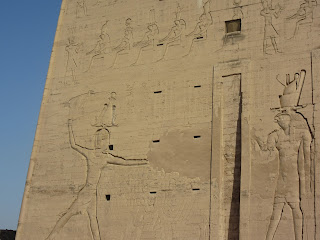



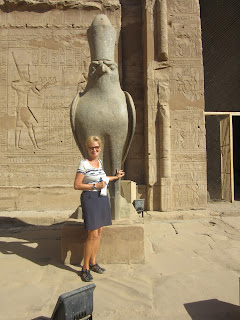



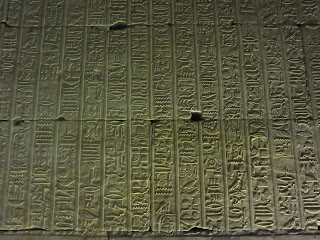





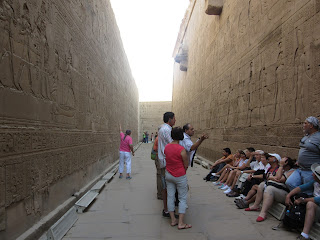















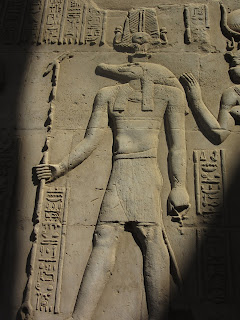









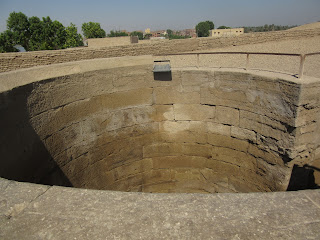

















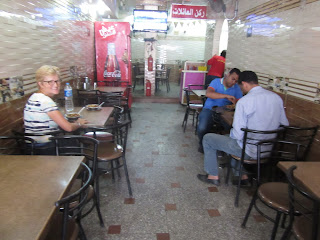










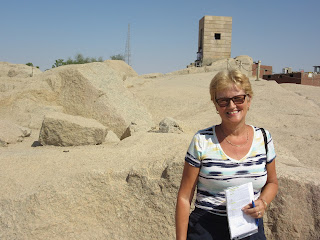
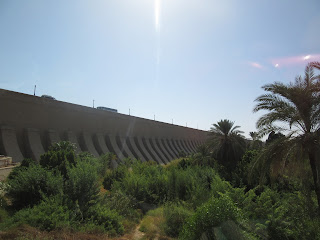




































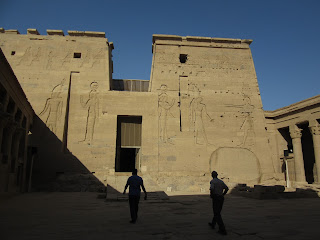





















Only the Egyptians would be able to tear down and rebuild something if that magnitude in the present day. If the perfume had broken, everyone would have have wanted to smell the suitcase!
ReplyDelete